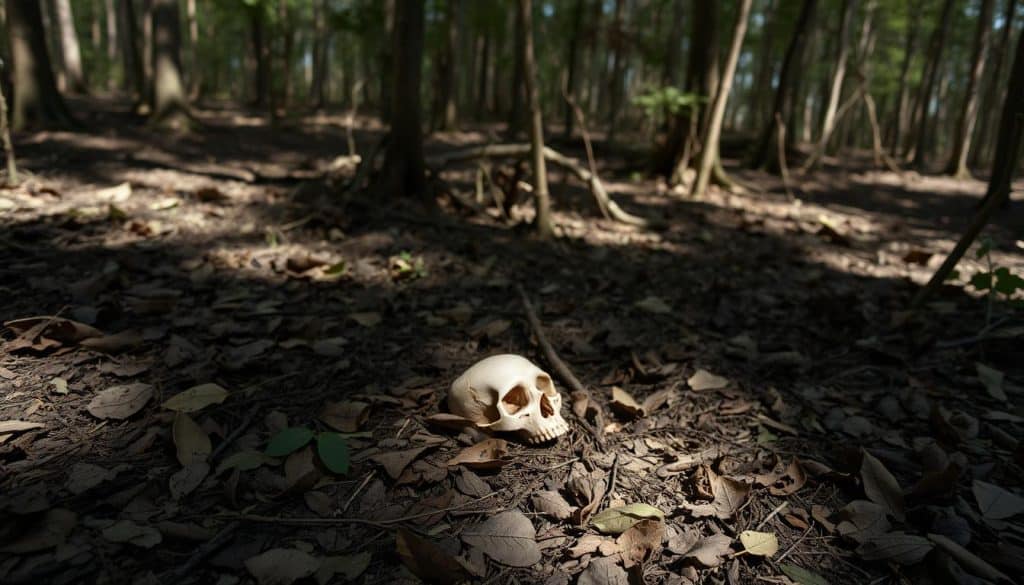In June 2008, a quiet neighborhood in Orlando, Florida, got national attention. Caylee Anthony, just two years old, was reported missing. It was a normal summer day with kids playing and neighbors gardening.
Casey Anthony’s initial 911 calls were confusing. They sparked a range of emotions and suspicions. These calls began the unraveling of a case that still captivates and divides opinions.
A wave of investigations and media attention followed. The courtroom drama was tense. Judge Belvin Perry thought Casey Anthony might have accidentally killed Caylee, maybe with chloroform1.
The trial went on for 33 days. In the end, Casey Anthony was acquitted of murdering her daughter but found guilty of giving false information2. People from everywhere delved into the details, forming theories and debating. Join us as we explore the facts and theories of this bewildering legal story.
Key Takeaways
- The Casey Anthony case began with the disappearance of Caylee Anthony in June 2008.
- Casey Anthony’s trial lasted 33 days, leading to a not guilty verdict on the murder charge2.
- Judge Belvin Perry speculated that Caylee’s death was likely an accident involving chloroform1.
- Despite being found not guilty of murder, Casey was convicted on charges of lying to law enforcement2.
- The case has spawned a wealth of theories and continues to intrigue the public and media alike.
Introduction to the Casey Anthony Case
Casey Anthony’s trial caught the attention of the nation, leading to widespread media attention and public fascination. This case began with a string of tragic events in 2008, centering around the disappearance of Caylee Anthony, Casey’s daughter.
The Disappearance of Caylee Anthony
On July 15, 2008, Caylee Anthony was reported missing by her grandmother, Cindy Anthony. This report sparked a series of investigations that pointed towards Casey Anthony3. It was reported that Caylee was last seen with Casey on June 16, 2008, after leaving a family gathering4. Casey was arrested the following day, July 16, 2008, facing charges of child neglect and obstructing a criminal investigation among others4.
Initial 911 Calls
Cindy Anthony’s first 911 calls were alarming. She initially reported a stolen vehicle and taken money. However, the situation grew more serious with her next claim about Caylee Anthony’s disappearance3. Cindy also mentioned a suspicious smell from Casey’s car, suggesting a decaying body3. These calls led to an intensive investigation, putting Casey Anthony and her family under severe pressure. The explosion of news stories and public curiosity would greatly influence the legal proceedings that followed.
Casey Anthony’s Charges and Arrest
The Casey Anthony trial grabbed nationwide attention with its shocking details. She first faced charges for lying about where she worked, if a nanny was taking care of Caylee, and what happened to her daughter. These lies started a long legal fight.
Initial Charges
Casey Anthony got arrested on July 16, 2008. Her charges were child neglect, lying to police, and getting in the way of a criminal investigation5. Her story didn’t add up, leading to more trouble. On October 14, 2008, a grand jury said she faced murder charges5. When they found Caylee’s remains in December 2008, the case reached a new level of seriousness6.
False Statements and Child Neglect
Casey Anthony was found guilty of lying to law enforcement four times. However, two of those convictions got thrown out later5. Her lies brought more charges, including child neglect. The court said she really didn’t care for her child’s well-being, which led to her bail denial5. On April 13, 2009, the case took a darker turn as prosecutors sought the death penalty5.
Key Evidence Presented During the Trial
The trial against Casey Anthony lasted for over a month and brought forward crucial evidence from both sides7. A big part of the case was forensic evidence. It significantly influenced the trial’s direction. One key piece of evidence was the finding of certain chemicals in her car’s trunk, suggesting decomposition7. Dr. Vass identified many compounds that are usually found when something decomposes7. The FBI confirmed a big portion of these compounds are linked to human decomposition7.
Certain insects found in the trunk also played a role because they are attracted to decaying bodies7. This evidence grabbed a lot of attention and led to many discussions. The discovery of a large amount of chloroform in the trunk supported the idea of wrongdoing7. However, the defense questioned the reliability and interpretation of the forensic evidence, aiming to create doubt among the jurors.
The forensic evidence was crucial for the prosecutors, as they tried to connect Casey Anthony to the crime. The six-week trial saw intense debates over this evidence8. Although Casey was acquitted of the most serious charges, she was found guilty of lying to the police. This led to a four-year prison term and a $4,000 fine8.
To summarize the key findings, let’s examine a comparative table:
| Aspect | Details |
|---|---|
| Trial Duration | 33 days7 |
| Compounds Associated with Decomposition | 41 out of 4247 |
| Human Decomposition Compounds | 67%7 |
| Presence of Specific Insects | Megaselia scalaris, Diptera, Phoridae7 |
| Trial Length | Six Weeks8 |
| Resulting Sentence | Four Years in Prison8 |
| Monetary Fine | $4,0008 |
All these elements together created a detailed portrayal of the Casey Anthony case. They challenged both teams to carefully explain their views on the forensic evidence Casey Anthony.
Casey Anthony’s Defense Strategy
The defense strategy of Casey Anthony was complex. It aimed to create doubts about the prosecution’s story. This would lead to uncertainty in the jurors’ minds. Defense lawyer Jose Baez worked hard to challenge the charges. He also suggested different stories.
Defense Attorney Jose Baez’s Open Argument
Right from the start, Jose Baez, the defense attorney, took a bold approach. In his opening statement, he described Casey Anthony as a young mom struggling with past sexual abuse and emotional problems. This included sleeping issues and nightmares9. Baez argued Casey was not the villain portrayed by the prosecution. Instead, she was impacted by her tough experiences. Baez’s strategy was to gain the jury’s sympathy for Casey. This included casting doubts on the trustworthiness of others close to her, like her father.
Introduction of Alternative Theories
Jose Baez offered a shocking theory. He suggested Caylee, Casey’s daughter, accidentally drowned in their pool on June 16, 200810. He accused Casey’s dad, George Anthony, of hiding Caylee’s body to hide the accident. Baez also claimed George Anthony tried to blame Casey by placing evidence against her. This evidence was missing gas cans from a shed. The cans had duct tape similar to what was found on Caylee10. Moreover, Baez stated Casey was hurt by her father and brother. This led her to hide her pain and her daughter’s death10. George Anthony, however, denied these claims in court.
Additionally, Baez challenged the credibility of Kronk, the man who found Caylee’s remains. He suggested Kronk moved the body to get a reward10. The defense’s goal was to create enough doubt. This would make it hard for jurors to convict Casey. Every part of the defense was carefully planned. This was to present different possibilities and move the attention from Casey to other possible suspects and stories.
The Verdict and Its Aftermath
After 11 hours of talking, the jury cleared Casey Anthony of major crimes because of weak evidence. This decision came despite claims she used chloroform and duct tape to harm her daughter1112. In the end, Casey was only found guilty of misleading the police11.
Jury Deliberation and Decision
The jury’s verdict faced a lot of scrutiny because the trial was so big. They talked it over for two days. But they cleared Casey of the biggest charges12.
Even with claims of chloroform use, the jury felt the proof wasn’t strong enough to find her guilty of murder.
Public Reaction to the Verdict
The public was really upset and angry about Casey Anthony’s acquittal. People doubted the justice system’s effectiveness in this case. The Casey Anthony verdict led to a big conversation. It prompted laws like “Caylee’s Law” in some states to improve how missing persons cases are reported11.
Over 300,000 people signed a petition for “Caylee’s Law,” showing they want change11.
Also, people still talk and wonder about what really happened in the Casey Anthony case12. For more details on the Casey Anthony trial, please see this information.
Casey Anthony Today: Life After the Trial
After her trial, Casey Anthony sought a normal life, despite public eyes on her. Almost 100 million people tuned into her trial’s verdict. It became one of the most viewed globally13. Today, Casey Anthony lives quietly yet sometimes appears in public14.
Casey has chosen a life away from media in South Florida. She launched a private investigation business in December 2020, named Case Research & Consulting Services, LLC15. By November 2022, the business was still up but finding clients was tough1415. Before this, she tried running a photography business that closed after three years1415.
Occasionally, Casey Anthony is seen around Orlando, Florida, where she was last seen in April 202315. Despite past legal issues, she enjoys social scenes like underground poker and private events, noted in August 2021 reports15. She also assists Patrick McKenna, her defense team’s lead investigator14.
Casey’s life is also marked by her separation from her family. This fallout came from the pressure of public attention14. Yet, she aimed to share her side in the “Casey Anthony: Where the Truth Lies” documentary in November 202215.
Public and Media Reaction
The Casey Anthony trial became a huge story in 201116. An Orlando court gave out 600 press passes, showing the massive media interest16. Time magazine called it the century’s first “social media trial,” because of how much social media affected it16. Casey Anthony became very unpopular after her daughter Caylee went missing. This led to a lot of negative attention in 201116.
Twitter was buzzing with talk about the trial. When the verdict came, 325,000 tweets were sent. Only 1% were in favor of Casey Anthony16. Most people did not support her, confirmed by a poll in 201216. Dr. Carole Lieberman mentioned that people thought Casey was guilty even if the evidence wasn’t clear17. She said the media hype led to a desire for revenge17, which made the public even angrier when Casey Anthony wasn’t found guilty.
Media Coverage During the Trial
U.S. media couldn’t get enough of the Casey Anthony trial, making Casey and Caylee well-known names18. Al Jazeera English, however, chose not to follow the trial, showing differing media choices in big cases18. Some journalists, like Howard Kurtz and Jeff Toobin, criticized the excessive media frenzy16. They called the coverage a “media carnival,” suggesting it was more for entertainment than news16.
Comparisons to Other High-Profile Cases
Many compared the Casey Anthony case to other notable ones, like the O.J. Simpson trial17. These comparisons were mainly because both Casey and O.J. Simpson were found not guilty17. Celebrities like Kim Kardashian and Sharon Osbourne also voiced their shock at the verdict17. Despite all the media and public focus, Casey Anthony wasn’t convicted of murder. This shows a gap between media stories and legal outcomes18. It tells us that journalism needs to be careful and avoid sensationalism and false information in big cases18.
Psychological and Forensic Testimonies
Casey Anthony’s trial was deeply influenced by forensic testimonies and a look into her mind. Dr. Harry Krop, a clinical psychologist, spent about 20 hours with her. He found no signs of major mental illnesses like schizophrenia or bipolar disorder19.
Dr. Krop’s findings made people wonder if it’s easy to fool forensic psychologists. Casey Anthony had shown she could lie and steal without guilt. Yet, she was not diagnosed with any psychological disorder19. This raises a big question: Can others hide their true selves, too, without a detailed mental check-up20?
The trial’s defense team had to tackle Casey Anthony’s questionable actions. They said her father abused her, leading to her troubled behavior. George Anthony denied it, but the claim was crucial for the defense. They also thought Caylee might have drowned by accident20.
Yet, the trust in forensic testimonies was shaky due to inconsistent mental health evaluations. Experts often disagree on diagnosing mental health issues. This makes it harder to trust such evaluations, especially if a defendant might trick the system19.
Not every defendant with psychological evidence has a mental disorder, says Dr. Krop. Casey Anthony didn’t show clear disorder symptoms, but the pressure and media attention could have affected her. This shows how complex and careful assessments need to be in trials involving psychological evidence and forensic testimonies19.
| Psychological Aspect | Casey Anthony Case |
|---|---|
| Hours Met by Dr. Harry Krop | Approximately 20 hours19 |
| Axis I Disorders Identified | None19 |
| Axis II Disorders Identified | None initially, later narcissistic traits19 |
| Defense Allegations of Abuse | Alleged by Casey, denied by George Anthony20 |
| Possible Motivations | Anger, jealousy, convenience, desire for freedom20 |
Casey Anthony Trial: Main Theories of Caylee’s Death
In 2008, the sad story of Caylee Anthony’s death took over the news. Many ideas about what really happened to her were brought up at the trial. These theories got attention from all around the world and key figures became central to the story.
The Accidental Drowning Theory
The defense suggested Caylee died by accident in the pool. They said Caylee’s grandfather, George Anthony, knew and tried to hide the truth. This claim was challenged by both the prosecutors and George Anthony, who said he was not involved.
The Role of George Anthony
George Anthony was closely looked at during the trial. The defense stated he had a big role in hiding Caylee’s body after she drowned21. People were split on whether George had done something wrong. Yet, Casey Anthony was found not guilty of murder and other major charges in 20112122.
Involvement of Convicted Kidnapper Vasco Thompson
The trial took a strange turn with the mention of Vasco Thompson, a known kidnapper. The defense tried to link him to George Anthony. But, the court found no real proof against Thompson in Caylee’s case. The accusations against Thompson were seen as unfounded and ignored.
The trial of Caylee Anthony’s death was complicated with many angles like the pool accident idea, George’s supposed role, and Vasco Thompson’s brief link. These aspects made the trial a big deal, drawing in 40 million people worldwide in 201121.
Evidence of Decomposition
A big part of the case against Casey Anthony focused on what was found in her car’s trunk. We’ll look at the hair and odor evidence that was very important in court.
Hair and Odor Analysis
The study of air from the trunk found interesting clues. It showed a lot of chloroform, a chemical you might find in bleach. Here, it was way more than normal23. This difference was a key point for the prosecutors.
Then, they looked at hair and found one that looked like Caylee Anthony’s, with signs of decay. This supported the theory that there was a body in the trunk at some point. The hair had a “dark band” seen when a body decomposes24.
More tests found seven compounds connected to human decay in the trunk24. These findings were vital for the claim that a body had been there. Especially, five of these compounds helped show how far along the decay was24.
They also found specific acids in the trunk that tied back to decomposition and making chloroform24. Evidence pointed to a human body decomposing.
The smell study showed signs of human decay. Laser tests found substances from decay, adding to the case against Casey23. They took six different air samples from the trunk for this detailed study23.
Last, the chloroform in the trunk was much more than what’s normally found outside. This fact supported the theory of decay and chemical use in Casey’s car24. The prosecutors built their argument using all this evidence and the detailed hair study24.
Presence of Chloroform
The Casey Anthony case was heavily influenced by the discovery of chloroform. Evidence such as the amount in Anthony’s car trunk and her online searches played a big role.
Chloroform Levels in the Trunk
Examination of air from Casey Anthony’s trunk found various substances, including notable amounts of gasoline and some chloroform25. A specialist found a “shockingly high” level of chloroform in the trunk’s carpet25. Yet, there was no chloroform on Caylee’s car seat, inside the car, or the steering wheel cover25.
This difference in chloroform levels led to many questions. At the 2011 trial, the evidence showed trunk chloroform levels were unexpectedly higher than usual26.
Cyber-Evidence of Chloroform Searches
In the case, online evidence also played a key role. Cindy Anthony, Casey’s mom, said she searched “chloroform” 84 times in March 200827. But, work records indicated she was at her hospital job when these searches were made27. Cindy Anthony’s boss confirmed that lying about work hours was illegal, making the situation more serious27.
Further, computer expert Kevin Stenger testified, challenging Cindy’s claim of possibly searching for “chlorophyll” instead27.
Together, the chloroform evidence found in Casey’s trunk and online were controversial during the trial. The prosecution argued it indicated planning, but the defense doubted the findings. They argued the evidence didn’t conclusively show Casey Anthony used chloroform on Caylee2726.
Insect Activity and Its Significance
In the Casey Anthony trial, studying insects was key to understanding the crime scene in her car trunk. Experts found signs of decomposition, suggesting something very wrong. But, their differing opinions made the facts unclear.
Dr. Neal Haskell, an expert in forensic entomology, stood out in the 2011 trial. His work has helped solve cases by dating death times back to 750 AD28. He’s known globally, thanks to his research and 11 grants28.
Blow flies are usually the first to find dead bodies because they can smell death from far away29. With new tech like PCR kits, experts can now tell the time since death within two hours29. This is key in solving cases.
Dr. Haskell shared that bugs make up 40% of all Earth’s creatures, with nearly 1 million known and over 10 million unnamed28. His deep understanding helps in estimating time since death with up to 95% accuracy, thanks to research in forensic entomology’s ecology and evolution29.
Studying the bacteria on dead bodies can reveal the person’s background. This is because of how bacteria and certain insects, like black soldier flies, attract each other29. Knowing how insects and bacteria work together is vital in forensic studies.
Casey Anthony: The Role of the Jury
The jury played a key role in the Casey Anthony trial, shaping how people view justice in famous cases. This group, consisting of seven women and five men, stayed in a hotel for two months. They listened to 33 days of evidence, going through over 400 pieces of evidence and hearing 91 witnesses30. Despite the glare of media, with 40 million Americans tuning in, they found Casey Anthony not guilty of the more severe charges. They acquitted her of murder and child abuse30, leading to widespread shock and anger across the country.
Understanding the Jury’s Decision
The jury based their decision on the concept of “beyond a reasonable doubt.” The case against Casey Anthony included dubious Google searches and the smell of decay in her car31. However, with no DNA or fingerprints linking her to Caylee’s death, it was hard for them to convict31. One of the men on the jury regretted not considering charges of aggravated manslaughter or child abuse. He talked about how the case still affects him30.
Several women on the jury felt terrible about their decision but pointed out the absence of clear proof. They underlined the hefty burden on the prosecution to prove its case31.
The CSI Effect and Its Implications
The “CSI effect” might have swayed the jury. This trend has jurors expecting solid DNA evidence inspired by crime shows like “CSI”31. In the Casey Anthony trial, the jury looked for hard DNA evidence that wasn’t there31. This gap in evidence likely led to their decision to acquit, despite the circumstantial evidence hinting at guilt31. Understanding this decision and the “CSI effect” explains much about the trial’s result.
| Factor | Impact on Jury |
|---|---|
| Sequestration for Two Months | Intensified emotional and psychological strain during deliberation30 |
| Lack of Direct Evidence | Contributed to reasonable doubt among jurors31 |
| CSI Effect | Increased expectation for DNA and forensic proof, influencing verdict31 |
Impact of the Verdict on Legal Proceedings
The Casey Anthony trial changed how we report missing children. It showed we needed new laws. This led to discussions on improving these laws.
Changes in Reporting Laws
The trial highlighted weaknesses in our reporting laws. There was a nationwide talk about these issues. Lawmakers saw the need for tighter rules to avoid such cases in the future32.
The case got a lot of media attention starting July 2008. This influenced public opinion and pushed for these changes33.
Creation of Caylee’s Law
Because of the trial, “Caylee’s Law” was created. It makes it a serious crime not to report a missing child quickly. States quickly passed this law to protect kids better32.
Learn more about its impact on the criminal justice system and how it affected public trust33.
Casey Anthony: Unexplored Theories
The trial of Casey Anthony caught everyone’s attention, leaving people split over Caylee Anthony’s death34. Many theories still haven’t been looked into, making the case an ongoing mystery. These theories include ideas not talked about in court, complicated by family issues and possibly other people involved.
One theory says the tough relationship between Casey and her mom, Cindy Anthony, is important. It suggests the family’s emotional problems might have affected what happened to Caylee34. Also, George Anthony’s odd actions and words hint at family secrets and maybe cover-ups35.
Then, there’s talk about outsiders playing a part, like Vasco Thompson, a known kidnapper. This adds more questions to an already puzzling case. People keep guessing and sharing ideas, trying to solve the mystery. For more info and different viewpoints about this, check out the full article here34.







